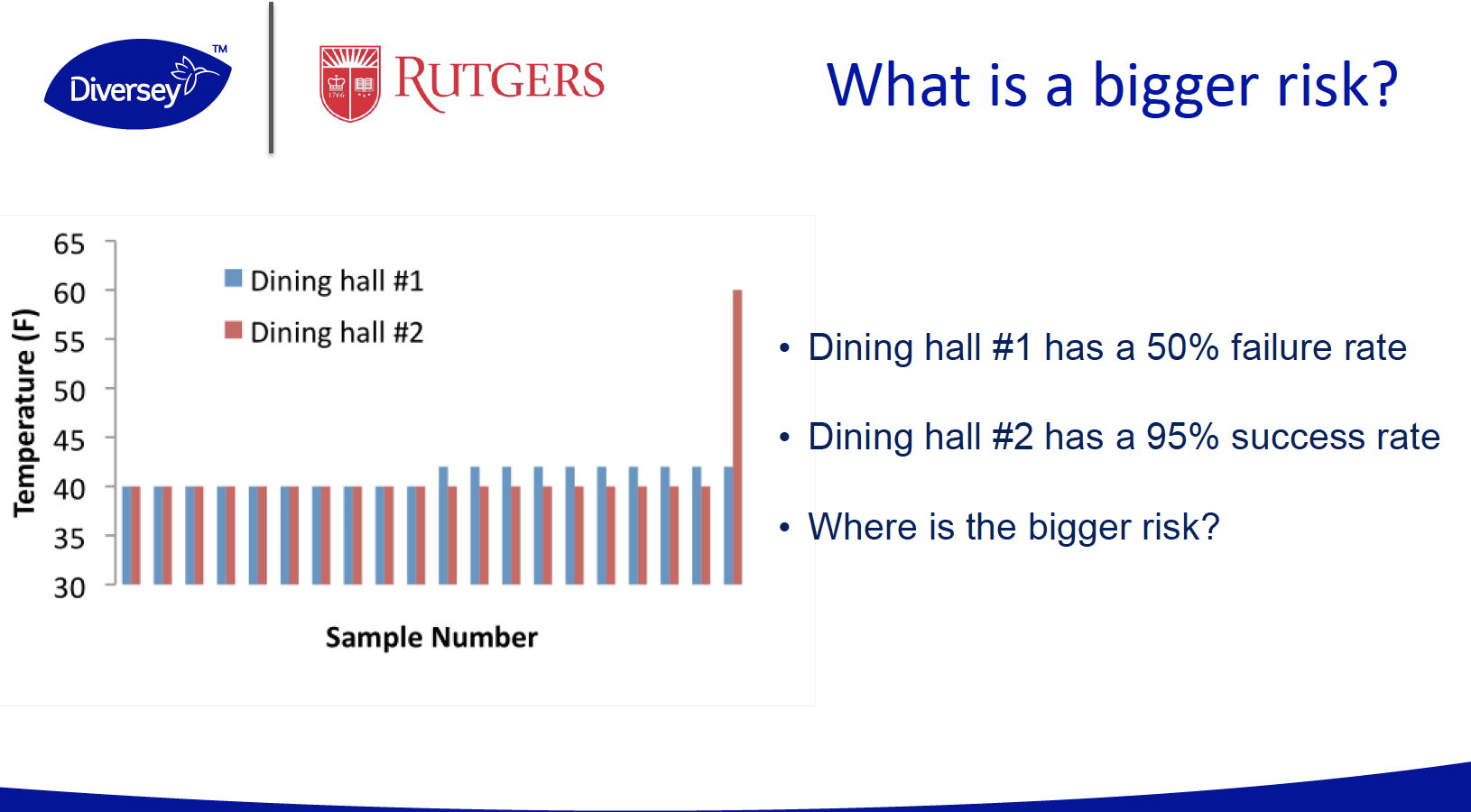My, how the world has changed in the short time since we were all together in Seattle! It is clear that food safety, even in a time of global crisis, cannot take a back seat. The topics we discussed at this meeting simply can’t be placed on the backburner. If anything, tools that give managers fast and simple ways to monitor and correct lapses in food safety behaviours are needed now more than ever.
As Dr. Don Schaffner said at Friday morning’s breakfast session: managerial tools are good, risk-based managerial tools are better, and risk-based managerial tools made easier by technology are the best. The examples he shared demonstrated the fact that nuances in our data are often overlooked in favor of categorical designations such as pass and fail. Consider the adjacent slide. Without access to any data beyond “pass” and “fail,” logic would imply you should direct resources towards fixing compliance issues at the wrong dining hall, but remember, “risk is related to severity and likelihood”. As Dr. Schaffner demonstrated, leveling up our technology by including algorithms predictive of risk can provide actionable feedback to managers that otherwise would be overlooked in traditional metrics.
We heard stories from Allison Jennings of Amazon entailing how they have used internal data to identify and remedy two food safety issues. As a major player in the grocery delivery sector, the Amazon team was faced with the issue of preventing cross contamination from raw meats and chemicals to other products in a customer’s delivery order. To resolve this issue, these products are placed in a specific type of bag to serve as a barrier. After noticing a lapse in usage of this barrier, they held additional training and meetings with associates and began auditing the process; but these didn’t move the needle enough. Next, they tried integrating “bagging reminder” prompts into the software used internally, which resulted in an increase in compliance. They continue to collect data and evaluate this approach, and I look forward to hearing more outcomes next year, in Singapore.
Allison also shared details on their industry-leading pre-op ATP program. Analyses pointed them towards a facility presenting as an outlier in pre-op ATP failures. Using internal data, additional swabbing and security footage, they identified the root cause, which Allison revealed to a chorus of groans from her contemporaries in attendance. Their investigation found building service contractors were unintentionally re-contaminating food contact surfaces. They immediately retrained their staff, and used this lesson to initiate retraining cadences across all janitorial staff. Both stories highlight the value that we can deliver to ourselves by making use of the internal data that is as yet untapped. Identifying possible causes of observed lapses in this manner will allow us to develop tools which can provide managers with an array simple remedies to complex problems.
Such tools can provide cascading benefits to an organisation. Chris Jordan of Diversey shared an intriguing narrative on behalf of Chuck Seaman of HyVee. A few years ago, HyVee began a shift from manual logs to digital logging tools for food safety activities such as temperature logs. Through careful observation, they were able to optimise these tools over time to provide sleek and simple interfaces which helped drive employee and manager acceptance and use of said tools. This approach has been very successful for HyVee. They’ve seen a cultural shift at the store level; data has shown an empirical increase in awareness and compliance of food safety processes by both associates and managers. They are beginning to see fewer regulatory non-compliances and better audit scores in stores utilising this technology. Chuck and Chris provided some valuable lessons learned that can serve as a road map for others looking to emulate their approach:
- Start with a diverse team to define and address issues at beginning
- Define objectives early to help facilitate communication
- Small trials allow for quicker refinement
- Program simplicity makes employee engagement easy
- Sharing positive employee experiences helps other employees see the benefit
- Providing visibility of program helped reinforce the importance of food safety at all levels of their organisation.
Data scientists will become essential to food safety teams as technology inevitably transforms how we assess and enhance food safety culture and behaviours, but not all organisations have the capability to parse their internal data to derive actionable insights. If this is true of your organisation, I was speaking to you when I urged the breakfast session attendees to use recommendations from academia derived from industry data. For example, we’ve known for years that the presence of standing water is predictive of Listeria presence. If we were getting the most utility from public data, every sanitation audit would ask about the presence of standing water. The amount of unexploited data from academia continues to pile up. In Retail deli managers and associates have better food safety culture in stores with lower Listeria monocytogenes contamination, Haley Oliver and Sophie Wu delineated 40 manager and associate behaviors indicative of organisational food safety climate and individual food safety behaviors (Wu, 2020).
That is one example of a plethora of valuable data that are delivered to industry as published, peer-reviewed documents with recommendations included. Dr. Schaffner shared other examples in his presentation. There was a lot of talk about the “race to the top” at GFSI 2020. It seems to me that most of the stairway has been built. Chuck, Allison and Chris shared some blueprints. It’s time to start taking the steps.
This post was written and contributed by:
Jack Burnett
Food Safety Manager
Diversey



